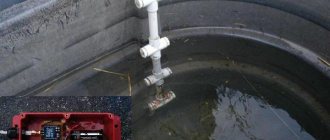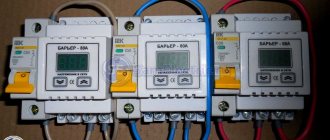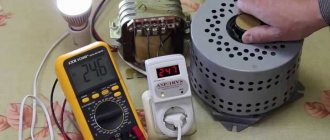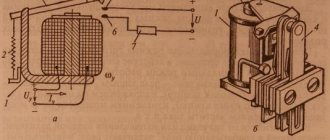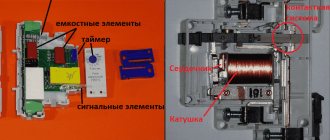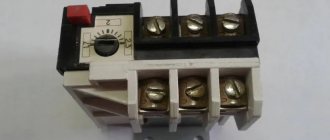In the following cases: • If the phase sequence is incorrect, switching on the electrical equipment is impossible. The contactor included in the RKF-11 closes the supply line only when all conductors are correctly connected. This is important for the direction of rotation of the electric motor. • If any of the phases breaks, the power is immediately turned off. The operation of three-phase electrical installations, and especially electric motors, with the loss of one, always leads to an accident. Unlike similar devices from other manufacturers, RKF-11 recognizes not only a break in a phase wire, but also a short circuit of a damaged conductor to another. • When the supply voltage exceeds the set value, a delayed shutdown occurs. Both the voltage limit (380-460 volts) and the delay time (0.5-5 seconds) are set by the user on the front panel. • When the voltage drops below a preset value, in the range from 300V to 380V, RKF-11 also turns off the load. If there is a significant voltage imbalance, the time delay for the protection to operate is automatically reduced.
Characteristics
| Options | Values |
| Switching wear resistance, number of cycles | 105 |
| Mechanical wear resistance, number of cycles | 106 |
| Mains voltage, V | 300 — 460 |
| Overvoltage adjustment range, Umax, V | 380 — 460 |
| Overvoltage delay time adjustment range, sec. | 0,5 — 5 |
| Voltage drop adjustment range, Umin, | B 300 - 380 |
| Range of adjustment of delay time by voltage drop, sec. | 1 — 10 |
| Relay response time in case of phase failure or error, no more than, sec. | 0,2 |
| Rated current of contacts, A | 5 |
| Power consumption, no more, W | 2 |
| Ambient operating temperature range, °C | -10 to +50 |
| Climatic performance | UHL4 |
RKF operation scheme
In the manufacture of the device, the latest microprocessors are used, which provide it with precision in settings and high reliability of parameters.
The basis of the RKF design is a microcircuit that controls the operation of the device. When the potential difference in a phase decreases or is completely absent, the microelectronic device signals an electromagnetic relay, which disconnects the load.
Parts of the device may include indicators of the level of asymmetry, as well as alternation of voltages on the phases and an element that regulates the response time.
The operating principle is to turn off the relay when an alarm is triggered. When three-phase voltage arrives at the device, the operating parameters of the network are monitored. If they are normal, the electromagnetic relay is activated.
If the test shows that even one indicator does not comply with the norm, then the RKF is automatically turned off. When the parameters return to normal values, the device automatically turns on. If several phases are disconnected, the device may turn off instantly.
Among the characteristics are:
- supply voltage;
- overvoltage control interval;
- voltage reduction interval;
- pause standards for switching on after a power surge or drop;
- period of time for shutdown in the phase loss position;
- size of contacts for switching operations;
- device power.
Features of operation and installation
When three-phase voltage is applied to the relay, if the voltage is within normal limits and the phase rotation order is observed, then relay contacts 8 and 10 close, and voltage is supplied to the motor contactor coil, which controls its activation. In the event of one of the emergency situations (phase failure, phase rotation error, overvoltage, voltage drop), contacts 8 and 9 are closed (8 and 10 are opened) and the contactor is turned off. In this case, the LED indicator also lights up, indicating the reason for the relay operation. Switching on occurs automatically after the correct supply voltage is restored. In the event of a phase failure or phase rotation error, the relay operates instantly (? 0.2 sec.); in the event of a voltage drop or overvoltage, the relay operates with a set delay of 0.5-10 sec. to avoid accidental engine shutdown during short-term power surges. If, after connecting the RKF-11, the engine or electrical installation does not start, and the “Phase Error” indicator is on, this means that a phase rotation error occurred during installation - you just need to set the correct phase connection order and repeat the start. The Phase Error indicator may flicker slightly when there is a slight imbalance in the power supply.
Definition and purpose of RKF
The device is used to create a stable operating mode for an electric motor or electrical installation powered from a three-phase network, preventing the risk of breakdown. Any threat to electrical equipment, impact on the quality of work or the efficiency of the technological process is interpreted as a signal to shutdown, and the RKF de-energizes the switching elements.
RKF, depending on the modification, is intended to solve the following problems:
- Switching of electrical converter equipment, for which it is necessary to observe the phase order.
- Protection of units with power up to 100 kW.
- Commissioning of ATS systems, or connection of an emergency lighting structure.
- Protection of low power electric drives up to 75 kW.
The device is used to protect control circuits that require constant monitoring of voltage values and other parameters of the electrical network.
In three-phase networks, RKF controls:
- Voltage level. Maintains the specified range, turning off the power on the line when it goes beyond the limits on one of the network phases.
- Phase loss. Performs a shutdown.
- Phase rotation. In case of erroneous location or phase adhesion, it establishes switching of electrical equipment.
- Phase imbalance. Implements switching when the phase or linear voltage value changes relative to the nominal one.
It is advisable to locate such devices where electrical equipment is constantly switching from one line to another, or when installing electric motors, where a possible phase imbalance can cause an increase in temperature and combustion of the stator windings.
Features of three-phase control relay
There are many modifications of relays. They are manufactured taking into account the needs of domestic networks, which experience interruptions and power surges. The devices delay the drawdown.
The indicator in a three-phase network is 380 V. There are small errors in this value, which are acceptable and do not cause harm to household equipment or electrical wiring.
But if the potential difference reaches large or too low values, serious troubles arise.
High voltage leads to overheating of wires and insulation, and electrical appliances and equipment connected to the network fail. At low values, equipment malfunctions and even shutdowns begin. For electric drives, the consequences of a voltage drop are even worse - they simply burn out. The problem can be avoided by connecting RKF.
The trading network sells a variety of phase control relays, which differ in design and functions. But their operating principle is the same. The device is compact, lightweight and has simple settings. Installed on a DIN rail in the panel.
Features of single-phase control relay
A single-phase voltage relay does not equalize the network potential difference. In the event of surges, the device instantly switches off the protected area. When the voltage in the network stabilizes, the electrical equipment is automatically reconnected to the power source.
Thanks to the timer, restarting occurs with a slight delay, thus ensuring the correct operation of electrical appliances. There is an objective possibility of adjusting and setting the delay time within the required limits.
The device is compact compared to various stabilizers, which allows it to be installed directly into the shield. In terms of performance, only expensive triac stabilizers are comparable to the device.
The advantage of the relay is its quiet operation.
RKF models
- SKM-01. The relay is manufactured by the Polish company Zamel. Checks phase rotation and asymmetry. It has a simple device.
- OMRON K8AB. The series is represented by eight modifications. Models with one measurement phase – K8AB-VS1, K8AB-VS2, K8AB-VS3, K8AB-VS4. They control the decrease and increase in the level of potential difference, acting as a limiter or arrester. K8AB-PA1, K8AB-PA2 – devices that monitor asymmetry, alternation and phase loss.
- RNPP-311. A Russian-made sample, one of the most common and acceptable for domestic networks. There are several modern variations that have additional options.
- EL-11. It is in high demand among buyers. The device is domestically produced and comes in various modifications. Monitors the performance of the electrical network and is mounted in a panel on a DIN rail.
It is not at all necessary to install phase control relays in private houses. But if owners want to protect their equipment from sudden power surges or other misfortunes associated with unstable operation of electrical networks, then they still need to think about purchasing and installing RKF.
A device that is incommensurate in price with possible losses will protect you from unnecessary expenses on the purchase of new equipment, and will simply make living and working at home more comfortable.

